AMD Launches Mobile Kaveri APUs
by Jarred Walton on June 4, 2014 12:01 AM ESTAMD Kaveri FX-7600P System/CPU Performance Preview
After the briefing, we were given a chance to benchmark a prototype Kaveri notebook for a few hours. That wasn't enough to run our full suite of laptop benchmarks, and battery testing in particular is something we couldn't perform. I did run some quick simulations of battery life; however, the prototype systems are optimized more for performance rather than power, so the results weren't really meaningful. We'll have to wait for retail laptops with Kaveri APUs before we can really see what sort of battery life to expect, but AMD claims there should be a decent jump in mobility compared to Richland.
The test systems were more of a proof of concept rather than anything you could actually sell. The keyboard was okay if a little mushy, but the touchpad in particular I found a bit lacking, and build quality was mediocre as well. The screens at least were good quality 1080p 15.6" touchscreen panels, and that was enough to get us benchmarking. I snapped a few pictures of the laptop that you can see above. In terms of other core specs, the laptop had 8GB of DDR3-1866 RAM and a Samsung M.2 256GB SSD.
For our purposes here, we're including the AMD Kaveri Prototype, AMD Trinity Prototype, and AMD Kabini Prototype laptops as a starting point. For retail laptops, we have the MSI GX60 with Richland A10-5750M APU (but only a single 8GB SO-DIMM, unfortunately), the Sony VAIO Pro 13 (i5-4200U), and the Acer V7-482PG (i7-4500U + GT 750M). The Acer is the only laptop equipped with a discrete GPU, so we wanted to see how Kaveri stacks up against such a system. You can compare additional results against Kaveri in Mobile Bench, of course.
Again, these numbers are only preliminary – the drivers for the GPU were slightly older (without Mantle support enabled yet), and there were occasions of odd behavior where other editors had scores that didn't match up with our results until after a reboot. We were not able to run each benchmark multiple times, so most of these results are from a single run. AMD is keen to talk about the GPU improvements with Kaveri, but I also wanted to see what has happened on the CPU side, so we'll start with our CPU/system benchmarks.
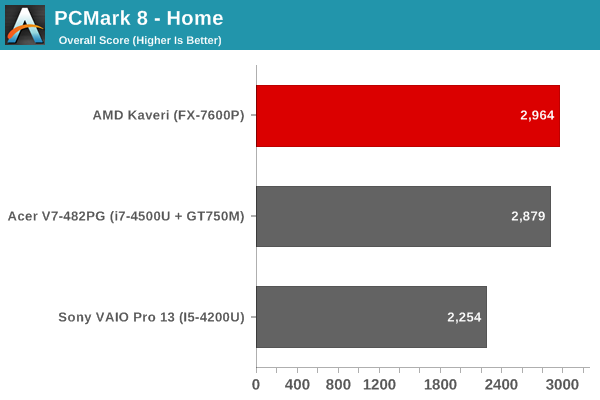
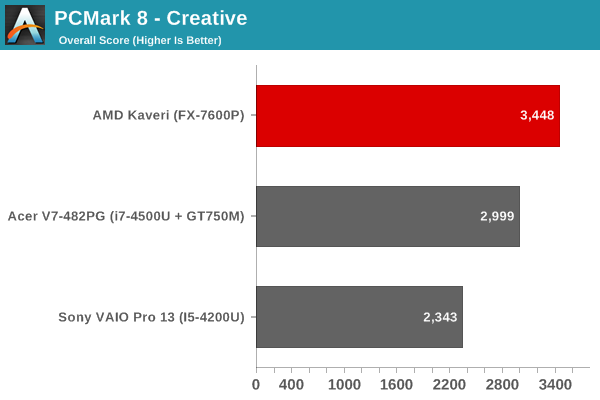

We don't have results for PCMark 8 for many of the systems, and the VAIO Pro 13 seems to be underperforming for some reason, but otherwise we get a pretty good idea of where things fall in terms of overall performance. Note that PCMark 8 is now OpenCL accelerated, which can improve performance quite a bit on AMD APUs. The result is that AMD actually takes the lead in the Home and Creative suites, but without more time benchmarking the system I wouldn't try to draw too many conclusions. Storage subsystem performance can still have an enormous impact on PCMark results, and the V7-482PG has to get by with an SSD caching solution. The VAIO Pro 13 on the other hand just seems to score a bit lower than I'd expect, so again take these scores with a grain of salt.
Moving on to other benchmarks, I also ran PCMark 7 as it doesn't have any OpenCL acceleration and will provide a better view of traditional application performance. Hopefully we'll continue to see improvements in the use of OpenCL (GPU) acceleration and over time PCMark 8 scores will be more indicative of real-world performance, but right now there are plenty of situations where having a GPU does very little for performance.

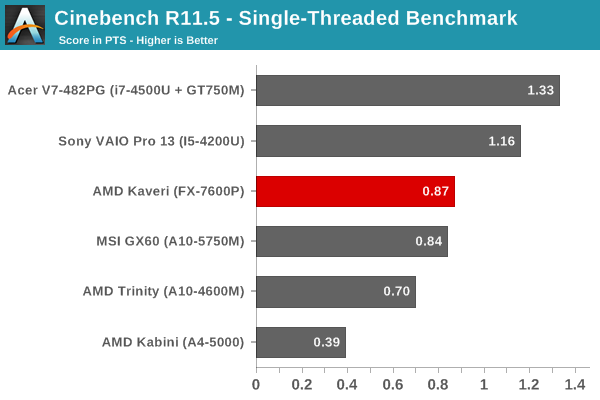
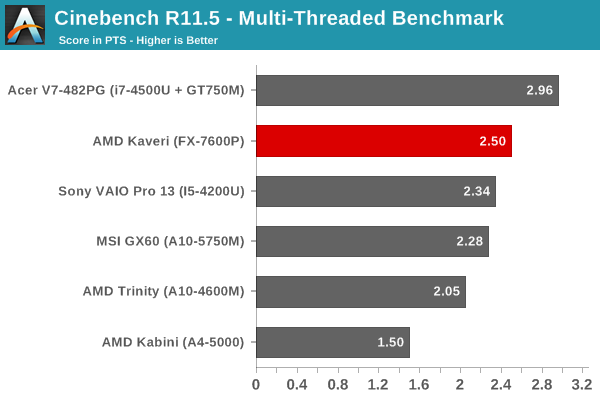
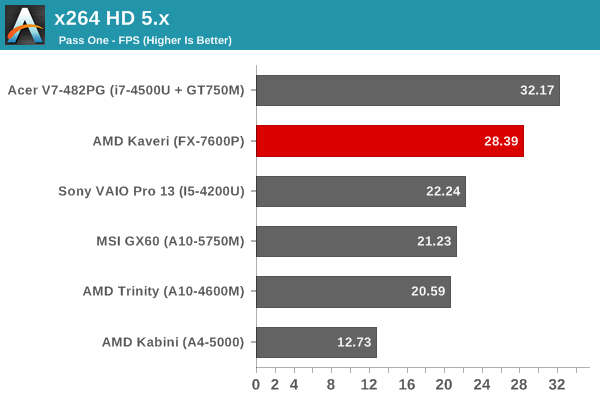
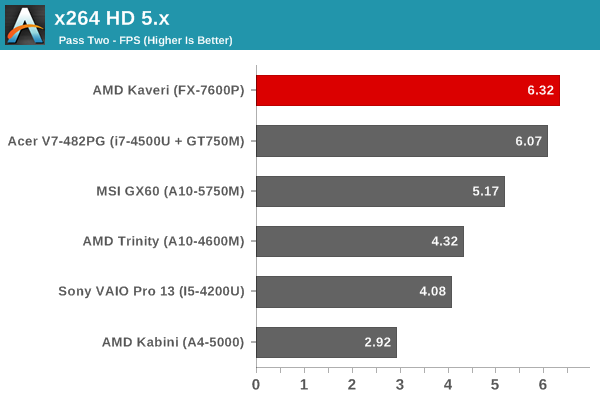
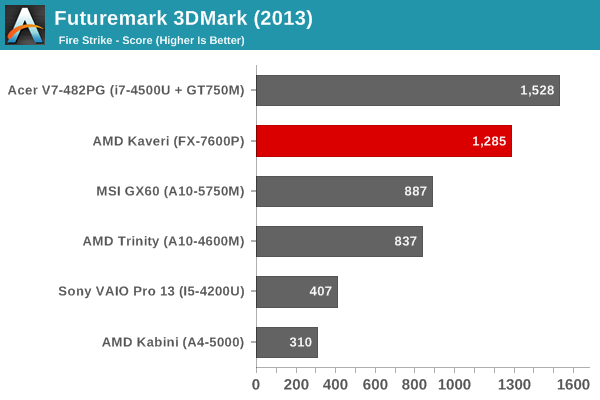
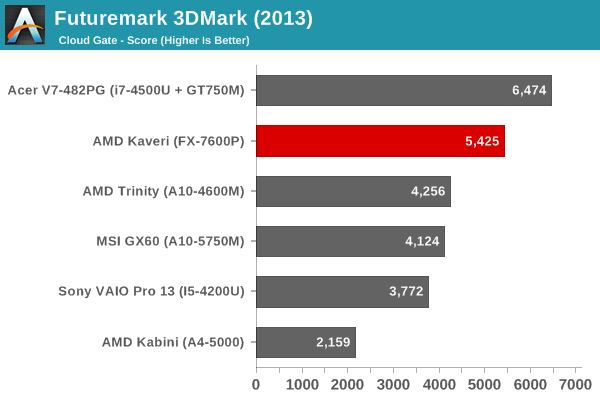

Somewhat surprisingly, Kaveri actually takes the lead in the very demanding second pass of the x264 HD 5.0 encoding test. Granted, we're looking at a 35W APU vs. 15W ULV CPU, and Intel's 37W quad-core parts would certainly retake the lead (and cost quite a bit more), but at least Kaveri is showing some real improvements over Richland in these tests. As noted above, PCMark 7 doesn't have any OpenCL optimizations so the gap between AMD and Intel is a bit wider.
Moving to the 3DMark results, Kaveri shows an impressive increase in performance over the Trinity/Richland GPU, which is expected. Intel's iGPU – particularly in the ULV system shown here – just doesn't stand a chance. While we are potentially TDP limited for the ULV Intel parts in graphics tests, my experience is that 3DMark hits the GPU much more than the CPU, so the GPU gets the lion's share of the TDP. I'll try to run some tests on other Haswell systems using the iGPU to verify the above results, but outside of the HD 5000 and Iris parts, I wouldn't expect Intel's iGPU to be too much faster than what we're seeing here.
Overall, an Intel CPU with a discrete GPU is still faster than Kaveri in most areas, and a quad-core i7-4702QM would really distance itself from AMD's Kaveri…but the quad-core i7 CPUs tend to start at around $350, so there's not much point in discussing that comparison. My personal feeling is that unless you're really pushing a laptop hard, most of the modern CPUs/APUs are plenty fast. I wouldn't want a Kabini APU, but Trinity/Richland, Ivy Bridge, Kaveri, and Haswell are all going to be fine for everyday use.
The more important element for me with a laptop (or desktop) is that I simply can't stand using conventional hard drives for the primary storage device any longer. Given the choice between an AMD Kaveri APU with a 256GB SSD (the Crucial MX100 is sure looking nice!) and pretty much any other laptop that has pure HDD storage, it's a no brainer for me. In fact, laptop manufacturers would do their customers a great service if they took the cost savings of AMD's APU vs. Intel's CPU and put that into a decent SSD solution rather than chasing the lowest possible price!


_thumb.jpg)
_thumb.jpg)
_thumb.jpg)
_thumb.jpg)
_thumb.jpg)








125 Comments
View All Comments
Flunk - Wednesday, June 4, 2014 - link
Under clocking the CPU and overclocking the GPU. that would be helpful. I've actually done this in a laptop that shares coolers between a discrete GPU and CPU but I imagine it would be useful in an APU laptop too.E.G. Note that the CPU is not underclocked in this test but I do normally underclock it to reduce the volume of the fan.
http://www.3dmark.com/3dm11/6039951
Meaker10 - Friday, June 6, 2014 - link
The GS60 with M290x, with an a10-5750 it's a questionably balanced system, with an ad 5550m at 3.6-3.7ghz it offers a great deal of value.Meaker10 - Friday, June 6, 2014 - link
Damn auto correct, gx60 not gs60.vladx - Wednesday, June 4, 2014 - link
There's a mistake on the 3rd page, it should be i5-4200U not 5200U afaik.texasti89 - Wednesday, June 4, 2014 - link
I looked straight for the single-threaded performance and I see the 15w 4500u gets >50% higher score than the 35W 7600P. Yes, graphics is good at that high TDP, but without a competitive CPU performance I think it's hard to justify these SKUs for the target market. AMD really needs to stop this disastrous adoption of bulldozer-based CPUs for good.
TrackSmart - Wednesday, June 4, 2014 - link
Three thoughts:1) I'm not defending AMD's single core performance, but the single-threaded cinebench test shows a 33% lead for the Intel Core-i5, which is not "greater than 50%". That said, I agree that AMD needs to close the gap on single-threaded CPU performance (and CPU performance-per-watt). This is as close as they've been in a long time, but the gap is still large. Their grand strategy has supposedly been to leverage the interaction of CPU+GPU to provide better performance, but when you are the minority player in the chip market, that's a tough hill to climb. How can you get software makers to write code for your APUS when they are only a fraction of the market *and* mostly found in the lowest-end consumer laptops?
2) Sure, multi-threaded CPU performance looks competitive here since AMD has thrown in more "cores" (purposeful use of quotation marks) for the same price as Intel, but that strategy can only go so far. At any time, Intel can choose to lower the price on its chips to match AMDs performance-per-dollar because Intel's chips use less silicon to produce the same CPU performance.
3) Anand is right that AMD needs to get these chips into nice laptops -- with lower-than-Intel prices -- and emphasize the gaming performance advantage. And those laptops had better have good battery life under normal usage. The presumed niche would be for an AMD laptop with reasonable gaming chops at several hundred dollars less than an Intel laptop with a discrete GPU.
That said, 35 watts is too high for the ultrabook form factor. Will AMDs graphics advantage remain this large when you move down to a 15 Watt APU? If the answer is no, then Anand's ideal doesn't really work. All you would get is a $50 cheaper AMD laptop with slower CPU performance and similar GPU performance!
[Note: I'm really rooting for AMD, but I'm going to remain cautious in my enthusiasm for these new chips until I see them in actual laptops. As they say, the proof is in the pudding.]
Natfly - Wednesday, June 4, 2014 - link
> I'm not defending AMD's single core performance, but the single-threaded cinebench test shows a 33% lead for the Intel Core-i5, which is not "greater than 50%".1.33 / .87 = 1.53. 53% faster.
TrackSmart - Thursday, June 5, 2014 - link
Yes, but the core i5 I specifically refer to is only a 33% difference. I'm guessing you were looking at the i7. So we are both wrong and both right. And in agreement about the need for better single threaded performance.piroroadkill - Wednesday, June 4, 2014 - link
Nice chip. But that said, without battery life results, this review does fall flat, I understand that they couldn't be done, though.Other than that, you've touched on the main issue with AMD based laptops: nobody wants to make a good one.
Give me something like my old Sony Vaio Z12 with that FX-7600P in it, at a decent price, and you have a compelling product. I don't want ridiculous resolutions. I want one that will work well for games and desktop use at a nice size. The Z12 @ 13.1" 1600×900 offers that absolutely perfectly in my opinion.
Homeles - Wednesday, June 4, 2014 - link
"From what I could gather, AMD used "V" transistors in Trinity/Richland but has switched to "T" transistors for Kaveri, which explains the drop in maximum clock speed."Perhaps, but the most important reason was the regression from PD-SOI to bulk.
Interesting claim there about the transistor "shapes." I've not heard of T and V shaped transistors... it appears to be the shape of the gate.